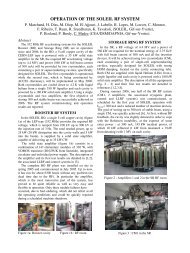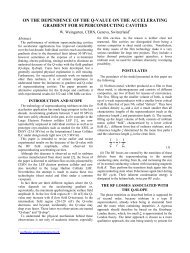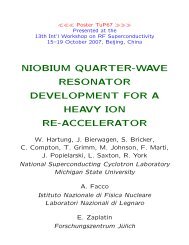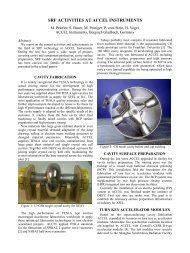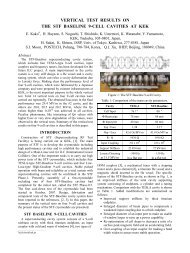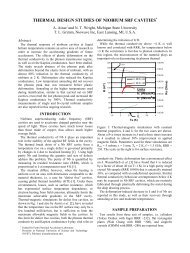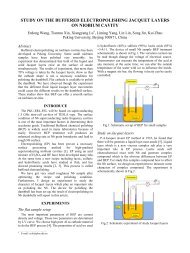XFEL: PLANS FOR 101 CRYOMODULES
XFEL: PLANS FOR 101 CRYOMODULES
XFEL: PLANS FOR 101 CRYOMODULES
Create successful ePaper yourself
Turn your PDF publications into a flip-book with our unique Google optimized e-Paper software.
Operational Gradient [MV/m]Overall Module performanceOn a recent test an accelerator module was thermallycycled 11 times. During these tests it could be verifiedthat the alignment of the cavities and the magnet packageis behaving reproducibly between warm and cold position.In addition, no leaks have occurred which indicates thatthe current design of flanges and seals can be used for the<strong>XFEL</strong> as well.In addition the static and dynamic losses wheremeasured and are acceptable within <strong>XFEL</strong> performance.RF PerformanceA significant time of testing was used to study the RFperformance of the accelerator modules. The acceleratinggradient specified for the <strong>XFEL</strong> is 23.8 MV/m for thesuperconducting cavities. Several accelerator moduleshave achieved this performance (Figure 4)[7].3530252015105Cavity averageOperational in FLASH<strong>XFEL</strong>ILCcouplers at a time, so that each module shows two entries.Only during the first operation of CMTB extended timesof more than 100 hours for conditioning were needed.This was caused by extremely tight thresholds on thecoupler vacuum interlock. After proper setting of thisinterlock value (comparable to levels used in other teststands at DESY) conditioning times are down to anacceptable level of 20 hours. One should note that theconditioning is done to levels of 1 MW for pulse lengthup to 400 us and 600 kW up to 1.3 ms which wouldsatisfy even ILC requirements [8].MTS couplers test: RF power-on time [hr]1501401301201<strong>101</strong>009080706050403020100moduleM6-1256M6-3478M7-1256Figure 5: RF conditioning times for the high powercouplers on CMTB. Couplers were conditioned four at atime (Courtesy D. Kostin – DESY).M7-3478M5-34781300μs800 μs400 μs200 μs100 μs50 μs20 μsP MAX=700kWIGP vacuum pressure IL limit set to 10 -6 mbarM5-125601 2 3 1* 4 5 6 7Module NumberFigure 4: Accelerating gradients of cryomodules built atDESY. The figure shows the operational gradient which isaccessible with equal RF power distributed to all cavitiesand the average gradient of the cavities which can be usedwith more sophisticated RF distributions.In Figure 4 two data points are shown for each module:The operational gradient assumes a simple powerdistribution where each cavity is supplied with the sameRF power. This is the baseline power distribution schemefor the <strong>XFEL</strong> and the ILC. Both projects are developingmore advanced distribution schemes where each cavitycan be supplied with an individual power level suited bestfor its performance. Thus the average gradient (seconddata set in figure 4) of the cavities would become theoperating gradient. One clearly sees that the <strong>XFEL</strong>specification has been safely demonstrated. Also the ILCspecification is within reach and average acceleratinggradients of 30 MV/m have been demonstrated. The ILCspecification is 31.5 MV/m operational gradient for thecryomodules.Cavity Auxiliary PerformanceThe CMTB allows also investigations in much betterdetail on cavity auxiliary components i.e. the high powerinput couplers and the cavity frequency tuners. In figure 5,the RF conditioning times for the modules tested onCMTB are shown. Conditioning was always done for 4Figure 6: Detuning of a cavity within on RF pulse with(green) and without (blue) piezo compensation.The frequency tuners in the <strong>XFEL</strong> modules areequipped with a slow and a fast tuning system. The slowsystem uses a stepping motor with zero holding currentand is mainly used to compensate slow drifts of heliumpressure. The fast system uses piezoelectric actuatorswhich should counteract the detuning which occursduring one RF pulse due to Lorentz forces. This is neededto limit the RF overhead power for cavity amplitude andphase control to an acceptable level. Several tests haveshown that this concept can be used [9]. An example isshown in figure 6, where the detuning of a cavity operatedat a gradient of 35 MV/m with and without piezocompensation is shown. Again, the measured performanceis fully satisfying even for the more stringent ILCrequirements.
FUTURE TEST STANDS <strong>FOR</strong> THE <strong>XFEL</strong>For the testing of the large series of modules needed forthe <strong>XFEL</strong> and for the validation of the tunnel layoutconcept two new test stands are under construction orunder design, respectively. The first test stand is thetunnel mock-up, where a string of accelerator modulescan be installed into a tunnel segment on the surface withthe dimensions of the real <strong>XFEL</strong> tunnel to be constructedlater. This will confirm that the suspension of the modulesfrom the ceiling is feasible as initial results have indicated.In addition, the overall tunnel installation and transportconcept can be tested. In figure 7 a picture during theconstruction of the mock-up is shown. The constructionhas been finished by now.The second test stand to be constructed is theAccelerator Module Test Facility (AMTF). As for the<strong>XFEL</strong> all accelerator modules will be tested for theirperformance, the test capacity of the CMTB will not besufficient. The rate of cryomodule production will beroughly one per week. Given that the duration of a test isroughly 2 weeks at least 2 test stands are needed to matchthe production rate. Testing will include RF performanceand the cavity auxiliaries as well as the cryogenicperformance.In the AMTF also vertical cryostats for the low-poweracceptance tests of individual cavities are constructed.Currently it is planned to test each of the 808 cavities fortheir RF performance after delivery from industry beforebeing installed into the accelerator module. Four cavitieswill be tested in one cooldown.SUMMARYThe preparation for the <strong>XFEL</strong> is well advanced. Severalaccelerator modules have been built and meet the <strong>XFEL</strong>performance. Gradients in those modules are alreadyclose to what would be needed for the ILC thusdemonstrating the beneficial synergy between theseprojects. The CMTB has been proven to be an essentialtool for the testing of cryogenic accelerator modules. Thenew test stands (tunnel mock-up and AMTF) willdemonstrate the feasibility of the tunnel layout and serveas an important quality control for a series production ofaccelerator modules.Figure 7: Picture of the tunnel mock-up at DESY. Thefinal <strong>XFEL</strong> tunnel layout is included as a computersimulation.Figure 8: TDR version of the Accelerator Modules TestFacility. The final version to be built until 2009 will beavailable soon.ACKNOWLEDGEMENTThe author would like to thank all colleagues involvedin the preparation of the <strong>XFEL</strong> project for their support ofthis work. For help with figures and pictures, the authorwould like to thank especially H. Weise, D. Kostin and K.Jensch.REFERENCES[1] http://www.xfel.net[2] M. Altarelli et al. (editors), The European <strong>XFEL</strong>Technical Design Report, DESY, July 2006, DESY2006-097[3] http://flash.desy.de[4] R. Brinkmann, et al. (editors), TESLA - TechnicalDesign Report, volume II. DESY, March 2001.ECFA 2001-209, TESLA Report 2001-23.[5] http://www.linearcollider.org[6] Tesla Report 2001-36 (2001), The Tesla CryogenicAccelerator Module,s C. Pagani et al.[7] See also: D. Kostin, this conference.[8] See also: W.-D. Möller, this conference.[9] M. Liepe, W.D. Möller, S.N. Simrock, DynamicLorentz Force Compensation with a FastPiezoelectric Tuner, DESY TESLA-01-03, 2001


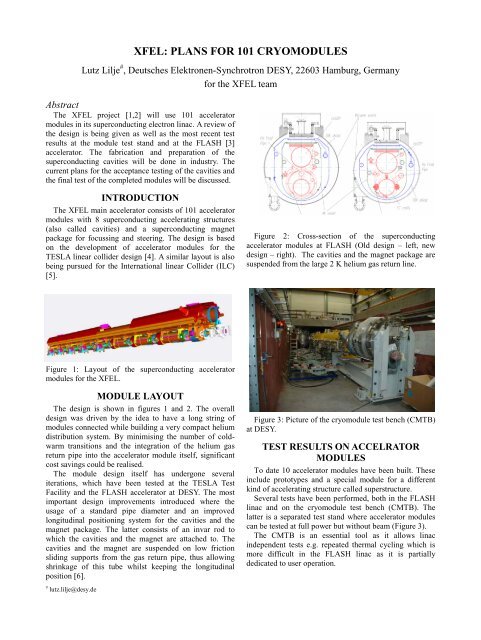
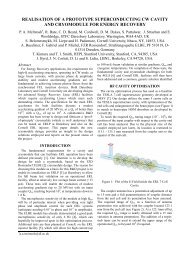
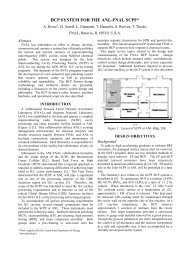
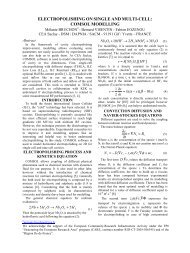

![å¨åæãæç©ä¿æ¤ææå¦ãï¼å¤§äºï¼ââå åºææååºç¨.ppt [å
¼å®¹æ¨¡å¼]](https://img.yumpu.com/42555314/1/190x135/aaaeaaeccaaeaeaea-ai-1-4-aai-1-4-aaa-aaeaeaacppt-a-1-4-araea-1-4-.jpg?quality=85)
